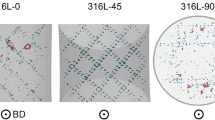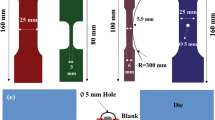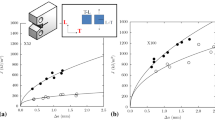Abstract
The mechanical performance of automotive structures made of advanced high strength steels (AHSS) is often seen reduced by the presence of cut edges. An attempt is made to assess and quantify the initial damage state and the damage evolution during mechanical testing of a punched edge and a machined edge via a recently developed 3D imaging technique called synchrotron radiation computed laminography. This technique allows us to observe damage in regions of interest in thin sheet-like objects at micrometer resolution. In terms of new experimental mechanics, steel sheets having sizes and mechanical boundary conditions of engineering relevance can be tested for the first time with in situ 3D damage observation and quantification. It is found for the investigated DP600 steel that the fracture zone of the punched edge is rough and that needle-shape voids at the surface and in the bulk follow ferrite-martensite flow lines. During mechanical in situ testing the needle voids grow from the fracture zone surface and coalesce with the sheared zone. In contrast, during in situ mechanical testing of a machined edge the damage starts away from the edge (∼800μ m) where substantial necking has occurred. Three-dimensional image analysis was performed to quantify the initial damage and its evolution. These data can be used as input and validation data for micromechanical damage models. To interpret the experimental findings in terms of mechanical fields, combined surface digital image correlation and 3D finite element analysis were carried out using an elasto-plastic constitutive law of the investigated DP steel. The stress triaxiality and the accumulated plastic strain were calculated in order to understand the influence of the edge profile and the hardening of the cutting-affected zone on the mechanical fields.
















Similar content being viewed by others
References
Dalloz A, Besson J, Gourgues-Lorenzon A-F, Sturel T, Pineau A (2009) Effect of shear cutting on ductility of a dual phase steel. Eng Fract Mech 76(10):1411–1424
Thomas DJ (2012) Effect of mechanical cut-edges on the fatigue and formability performance of advanced high-strength steels. J Fail Anal Preven 12(5):518–531
Lara A, Picas I, Casellas D (2013) Effect of the cutting process on the fatigue behaviour of press hardened and high strength dual phase steels. J Mater Proc Technol 213:1908–1919
Mazinani M, Poole WJ (2007) Effect of martensite plasticity on the deformation behavior of a low-carbon dual-phase steel. Metall Mat Trans A 38(2):328–339
Maire E, Bouaziz O, Di Michiel M, Verdu C (2008) Initiation and growth of damage in a dual-phase steel observed by x-ray microtomography. Acta Mater 56(18):4954–4964
Landron C, Bouaziz O, Maire E, Adrien J (2010) Characterization and modeling of void nucleation by interface decohesion in dual phase steels. Scr Mater 63(10):973–976
Avramovic-Cingara G, Saleh ChAR, Jain MK, Wilkinson DS (2009) Void nucleation and growth in dual-phase steel 600 during uniaxial tensile testing. Metall Mater Trans 40(13):3117–3127
Kadkhodapour J, Butz A, Ziaei Rad S (2011) Mechanisms of void formation during tensile testing in a commercial, dual-phase steel. Acta Mater 59(7):2575–2588
Azuma M, Goutianos S, Hansen N, Winther G, Huang X (2012) Effect of hardness of martensite and ferrite on void formation in dual phase steel. Mater Sci Technol 28(9–10):1092–1100
Ramazani A, Schwedt A, Aretz A, Prahl U, Bleck W (2013) Characterization and modelling of failure initiation in dpsteel. Comput Mater Sci 75:35–44
Park In-Gyu, Thompson Anthony W (1988) Ductile fracture in spheroidized 1520 steel. Acta Metall 36 (7):1653–1664
Avramovic-Cingara G, Ososkov Y, Jain MK, Wilkinson DS (2009) Effect of martensite distribution on damage behaviour in dp600 dual phase steels. Mater Sci Eng 516:7–16
Landron C, Bouaziz O, Maire E, Adrien J et al (2013) Experimental investigation of void coalescence in a dual phase steel using x-ray tomography. Acta Mater 61(18):6821–6829
Brown M, Embury D (1973) A model of ductile fracture in two-phase materials. In: The 3rd international conference on strength of metals and alloys, London, pp 164–169
Thomason PF (1990) Ductile fracture of metals. Pergamon Press
Argon AS, Im J, Safoglu R (1975) Cavity formation from inclusions in ductile fracture. Metall Trans 6 (4):825–837
Beremin FM (1981) Cavity formation from inclusions in ductile fracture of a508 steel. Metall Trans A 12 (5):723–731
Chu CC, Needleman A. (1980) Void nucleation effects in biaxially stretched sheets. J Eng Mater Technol 102(3):249–256
Rice JR, Tracey DM (1969) On the ductile enlargement of voids in triaxial stress fields. Journal of the Mechanics and Physics of Solids 17(3):201–217
Huang Y (1991) Accurate dilatation rates for spherical voids in triaxial stress fields. J Appl Mech 58 (4):1084–1086
Gurson AL (1975) Continuum Theory of Ductile Rupture by Void Nucleation and Growth: Yield criteria and flow rules for porous ductile media. Technical report (Brown University. Division of Engineering). Division of Engineering, Brown University
Bettaieb MB, Lemoine X, Bouaziz O, Habraken AM, DuchÃne L (2011) Numerical modeling of damage evolution of dp steels on the basis of x-ray tomography measurements. Mech Mater 43(3):139–156
Fansi Joseph, Balan Tudor, Lemoine Xavier, Maire Eric, Landron Caroline, Bouaziz Olivier, Bettaieb Mohamed Ben, Habraken Anne Marie (2013) Numerical investigation and experimental validation of physically based advanced {GTN} model for {DP} steels. Mater Sci Eng A 569:1–12
Besson J (2010) Continuum models of ductile fracture: a review. International Journal of Damage Mechanics 19(1):3–52
Pyttel T, John R, Hoogen M (2000) A finite element based model for the description of aluminium sheet blanking. Int J Mach Tool Manuf 40(14):1993–2002
Chen ZH, Tang CY, Lee TC (2004) An investigation of tearing failure in fine-blanking process using coupled thermo-mechanical method. Int J Mach Tools Manuf 44:155–165
Wu Xin, Bahmanpour H, Schmid K (2012) Characterization of mechanically sheared edges of dual phase steels. J Mater Proc Technol 212(6):1209–1224
So H, FaAmann D, Hoffmann H, Golle R, Schaper M (2012) An investigation of the blanking process of the quenchable boron alloyed steel 22mnb5 before and after hot stamping process. J Mater Proc Technol 212(2):437–449
Lee TC, Chan LC, Wu BJ (1995) Straining behaviour in blanking process - fine blanking vs conventional blanking. J Mater Proc Technol 48:105–111
Hambli R (2001) Comparison between lemaitre and gurson damage models in crack growth simulation during blanking process. Int J Mech Sci 43(12):2769–2790
Ridha Hambli (2002) Prediction of burr height formation in blanking processes using neural network. Int J Mech Sci 44(10):2089–2102
Hilditch TB, Hodgson PD (2005) Development of the sheared edge in the trimming of steel and light metal sheet: Part 1, experimental observations. J Mater Proc Technol 169(2):184–191
Mori K, Saito S, Maki S (2008) Warm and hot punching of ultra high strength steel sheet. {CIRP} Ann Manuf Technol 57(1):321–324
So H, Hoffmann H, Golle R (2009) Blanking of press hardened ultra high strength steel. In: Proceedings of 2nd international conference on hot sheet metal forming of high-performance steel. Luleo, Sweden, pp 137–145
Sartkulvanich P, Kroenauer B, Golle R, Konieczny A, Altan T (2010) Finite element analysis of the effect of blanked edge quality upon stretch flanging of ahss. CIRP Ann Manuf Technol 59(1):279–282
Mori K (2012) Smart hot stamping of ultra-high strength steel parts. Trans Nonferrous Met Soc China 22, Supplement 2:s496–s503
Mori K, Abe Y, Kidoma Y, Kadarno P (2013) Slight clearance punching of ultra-high strength steel sheets using punch having small round edge. Int J Mach Tool Manuf 65(0):41–46
Taupin E, Breitling J, Wu WT, Altan T (1996) Material fracture and burr formation in blanking results of {FEM} simulations and comparison with experiments. J Mater Proc Technol 59(1–2):68–78
Breitling J, Chernauskas V, Taupin E, Altan T (1997) Precision shearing of billetsspecial equipment and process simulation. J Mater Proc Technol 71(1):119–125
Goijaerts AM, Stegeman YW, Govaert LE, Brokken D, Brekelmans WAM, Baaijens FPT (2000) Can a new experimental and numerical study improve metal blanking? J Mater Proc Technol 103(1):44–50
Goijaerts AM, Govaert LE, Baaijens FPT (2001) Evaluation of ductile fracture models for different metals in blanking. J Mater Process Technol 110(3):312–323
Kim JH, Lee MG, Kim D, Matlock DK, Wagoner RH (2010) Hole-expansion formability of dual-phase steels using representative volume element approach with boundary-smoothing technique. Mater Sci Eng A 527 (27–28):7353–7363
Jha G, Das S, Lodh A, Haldar A (2012) Development of hot rolled steel sheet with 600 mpa uts for automotive wheel application. Mater Sci Eng A 552:457–463
Taylor MD, Choi KS, Sun X, Matlock DK, Packard CE, Xu L, Barlat F (2014) Correlations between nanoindentation hardness and macroscopic mechanical properties in {DP980} steels. Mater Sci Eng A
Wang Kai, Luo Meng, Wierzbicki Tomasz (2014) Experiments and modeling of edge fracture for an ahss sheet. Int J Fract 187(2):245–268
Hasegawa K., Kawamura K, Urabe T, Hosoya Y (2004) Effects of microstructure on stretch-flange-formability of 980 mpa grade cold-rolled ultra high strength steel sheets. ISIJ Int 44(3):603–609
Bouaziz O, Douchamps S, Durrenberger L, Bui-Van A (2010) The double bending test: a promising new way for an optimal characterization of cut-edges ductility. In: International deep-drawing research group, London, pp 164–169
Levy BS, Gibbs M, Tyne CJ (2013) Failure during sheared edge stretching of dual-phase steels. Metall Mat Trans A 44(8):3635–3648
Levy B, Van Tyne C (2012) Effect of a strain-hardening rate at uniform elongation on sheared edge stretching. J Mater Eng Perform:1–8
Levy B, Van Tyne C (2011) Review of the shearing process for sheet steels and its effect on sheared-edge stretching. J Mater Eng Perform:1–9
Gammage JJ, Wilkinson DS, Embury JD, Maire E (2005) Damage studies in heterogeneous aluminium alloys using x-ray tomography. Philos Mag 85(26–27):3191–3206
Maire E, Bordreuil C, Babout L, Boyer J-C (2005) Damage initiation and growth in metals. comparison between modelling and tomography experiments. Journal of the Mechanics and Physics of Solids 53(11):2411–2434
Maire E, Zhou S, Adrien J, Dimichiel M (2011) Damage quantification in aluminium alloys using in situ tensile tests in x-ray tomography. Eng Fract Mech 78(15):2679–2690
Landron C, Maire E, Bouaziz O, Adrien J, Lecarme L, Bareggi A (2011) Validation of void growth models using x-ray microtomography characterization of damage in dual phase steels. Acta Mater 59(20):7564–7573
Helfen L, Baumbach T, Mikulik P, Kiel D, Pernot P, Cloetens P, Baruchel J (2005) High-resolution three-dimensional imaging of flat objects by synchrotron-radiation computed laminography. Appl Phys Lett 86 (7):071915–071915–3
Helfen L, Myagotin A, Rack A, Pernot P, Mikulík P, Di Michiel M, Baumbach T (2007) Synchrotron-radiation computed laminography for high-resolution three-dimensional imaging of flat devices. Phys Status Solidi A 204:2760–2765
Helfen L, Myagotin A, Mikulík P, Pernot P, Voropaev A, Elyyan M, Di Michiel M, Baruchel J, Baumbach T (2011) On the implementation of computed laminography using synchrotron radiation. Rev Sci Instrum 82(6)
Xu F, Helfen L, Moffat AJ, Johnson G, Sinclair I, Baumbach T (2010) Synchrotron radiation computed laminography for polymer composite failure studies. J Synchrotron Radiat 17(2):222–226
Bull DJ, Helfen L, Sinclair I, Spearing SM, Baumbach T (2013) A synthesis of multi-scale 3d x-ray tomographic inspection techniques for assessing carbon fibre composite impact damage. Compos Sci Technol 75:55–61
Morgeneyer TF, Helfen L, Sinclair I, Proudhon H, Xu F, Baumbach T (2011) Ductile crack initiation and propagation assessed via in situ synchrotron radiation-computed laminography. Scr Mater 65(11):1010–1013
Shen Y, Morgeneyer TF, Garnier J, Allais L, Helfen L, Crépin J (2013) Three-dimensional quantitative in situ study of crack initiation and propagation in {AA6061} aluminum alloy sheets via synchrotron laminography and finite-element simulations. Acta Mater 61(7):2571–2582
Ueda T, Helfen L, Morgeneyer TF (2014) In-situ laminography study of three-dimensional individual void shape evolution at crack initiation and comparison with gtn-type simulations. Accepted for publication in Acta Materialia
Morgeneyer TF, Helfen L, Mubarak H, Hild F (2013) 3d digitavolume correlation of synchrotron radiation laminography images of ductile crack initiation: an initial feasibility study. Exp Mech 53(4):543–556
Tong W, Tao H, Jiang XQ, Zhang NA, Marya MP, Hector LG, Gayden XHQ (2005) Deformation and fracture of miniature tensile bars with resistance-spot-weld microstructures. Metall Mater Trans A Physical metallurgy and materials science 36A(10):2651–2669
Le Jolu T, Morgeneyer TF, Denquin A, Sennour M, Laurent A, Besson J, Gourgues-Lorenzon A-F (2014) Microstructural characterization of internal welding defects and their effect on the plastic behavior of FSW joints of AA2198 Al-Cu-Li alloy. Metall Mater Trans A 45:5531–5544
Douissard P A, Cecilia A, Rochet X, Chapel X, Martin T, van de Kamp T, Helfen L, Baumbach T, Luquot L, Xiao X, Meinhardt J, Rack A (2012) A versatile indirect detector design for hard x-ray microimaging. J Instrum 7(09):P09016
Myagotin A, Voropaev A, Helfen L, Hanschke D, Baumbach T (2013) Efficient volume reconstruction for parallel-beam computed laminography by filtered backprojection on multi-core clusters. IEEE Trans Image Process 22(12):5348–5361
Abramoff MD, Magelhaes PJ, Ram SJ (2004) Image processing with imagej. Biophoton Int 11(7):36–42
Landron C, Maire E, Adrien J, Bouaziz O, Di Michiel M, Cloetens P, Suhonen H (2011) Resolution effect on the study of ductile damage using synchrotron x-ray tomography
Morgeneyer TF, Besson J, Proudhon H, Starink MJ, Sinclair I (2009) Experimental and numerical analysis of toughness anisotropy in {AA2139} al-alloy sheet. Acta Mater 57(13):3902–3915
Hild F (2002) A software for displacement field measurements by digital image correlation. LMT Cachan, report 252
Besson J., Cailletaud G., Chaboche, Forest SJ-L (2010) Non linear mechanics of materials. Springer
Chaboche JL (2008) A review of some plasticity and viscoplasticity constitutive theories. Int J Plast 24 (10):1642–1693
Rèche D, Besson J, Sturel T, Lemoine X, Gourgues-Lorenzon AF (2012) Analysis of the air-bending test using finite-element simulation: application to steel sheets. Int J Mech Sci 57(1):43–53
Acknowledgments
The authors would like to thank ArcelorMittal Global R&D for financial support and material supply and Astrid Perlade for helpful discussions. The authors also acknowledge the ESRF for the provision of synchrotron radiation at ID19 beam-line through the MA1631 project.
Author information
Authors and Affiliations
Corresponding author
Rights and permissions
About this article
Cite this article
Kahziz, M., Morgeneyer, T.F., Mazière, M. et al. In situ 3D Synchrotron Laminography Assessment of Edge Fracture in Dual-Phase Steels: Quantitative and Numerical Analysis. Exp Mech 56, 177–195 (2016). https://doi.org/10.1007/s11340-015-0076-3
Received:
Accepted:
Published:
Issue Date:
DOI: https://doi.org/10.1007/s11340-015-0076-3




